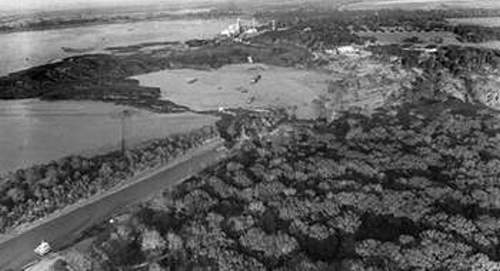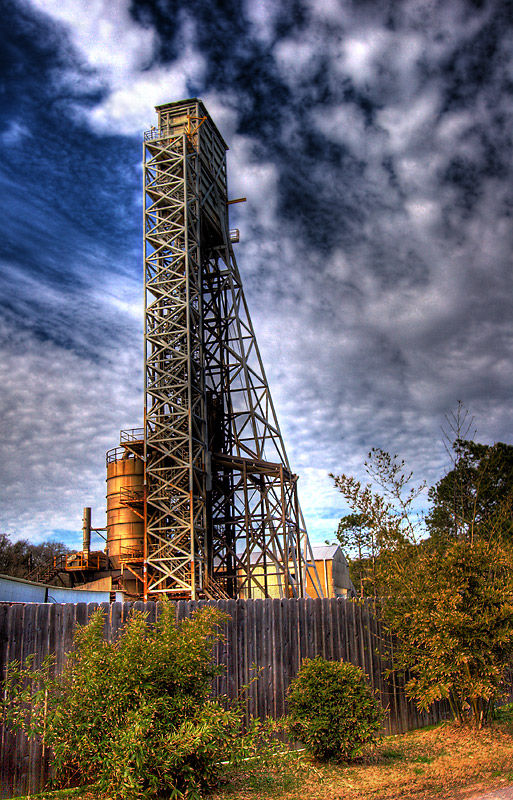|
Sinkholes Assorted |
||||||
|
New Iberia, Louisiana September 6, 2005 ..
Written by
Alan Bellows on September 28th, 2007 at 9:38 am
Alan, our managing editor, has until very recently been held captive in a programming forced labor camp. As he recovers from his schedule wounds, please enjoy this classic Damn Interesting article which was originally posted on 06 September 2005.
Lake Peigneur Early in the morning on November 21, 1980, twelve men decided to abandon their oil drilling rig on the suspicion that it was beginning to collapse beneath them. They had been probing for oil under the floor of Lake Peigneur when their drill suddenly seized up at about 1,230 feet below the muddy surface, and they were unable free it. In their attempts to work the drill loose, which is normally fairly easy at that shallow depth, the men heard a series of loud pops, just before the rig tilted precariously towards the water. At the time, Lake Peigneur was an unremarkable body of water near New Iberia, Louisiana. Though the freshwater lake covered 1,300 acres of land, it was only eleven feet deep. A small island there was home to a beautiful botanical park, oil wells dotted the landscape, and far beneath the lake were miles of tunnels for the Diamond Crystal salt mine. Concluding that something had gone terribly wrong, the men on the rig cut the attached barges loose, scrambled off the rig, and moved to the shore about 300 yards away. Shortly after they abandoned the $5 million Texaco drilling platform, the crew watched in amazement as the huge platform and derrick overturned, and disappeared into a lake that was supposed to be shallow. Soon the water around that position began to turn. It was slow at first, but it steadily accelerated until it became a fast-moving whirlpool a quarter of a mile in diameter, with its center directly over the drill site. As the whirlpool was forming on the surface, Junius Gaddison, an electrician working in the salt mines below, heard a loud, strange noise coming down the corridor. Soon he discovered the sound's source, which was rushing downhill towards him: fuel drums banging together as they were carried along the shaft by a knee-deep stream of muddy water. He quickly called in the alarm, and the mine's lights were flashed three times to signal its immediate evacuation. Many of the 50 miners working that morning, most as deep as 1,500 feet below the surface, saw the evacuation signal and began to run for the 1,300 foot level, where they could catch an elevator to the surface. However, when they reached the third level, they were blocked by deep water. Clearly, the salt dome which contained the mine had been penetrated by the drill crew on the lake. Texaco, who had ordered the oil probe, was aware of the salt mine's presence and had planned accordingly; but somewhere a miscalculation had been made, which placed the drill site directly above one of the salt mine's 80-foot-high, 50-foot-wide upper shafts. As the freshwater poured in through the original 14-inch-wide hole, it quickly dissolved the salt away, making the hole grow bigger by the second. The water pouring into the mine also dissolved the huge salt pillars which supported the ceilings, and the shafts began to collapse. As most of the miners headed for the surface, a maintenance foreman named Randy LaSalle drove around to the remote areas of the mine which hadn't seen the evacuation signal, and warned the miners there to evacuate. The miners whose escape was slowed by water on the third level used mine carts and diesel powered vehicles to make their way up to the 1,300 foot level, where they each waited their turn to ride the slow, 8-person elevator to the surface as the mine below them filled with water. Although it seemed to take forever to get out, all 50 miners managed to escape with their lives. Barges on the LakeMeanwhile, up on the surface, the tremendous sucking power of the whirlpool was causing violent destruction. It swallowed another nearby drilling platform whole, as well as a barge loading dock, 70 acres of soil from Jefferson Island, trucks, trees, structures, and a parking lot. The sucking force was so strong that it reversed the flow of a 12-mile-long canal which led out to the Gulf of Mexico, and dragged 11 barges from that canal into the swirling vortex, where they disappeared into the flooded mines below. It also overtook a manned tug on the canal, which struggled against the current for as long as possible before the crew had to leap off onto the canal bank and watch as the lake consumed their boat. After three hours, the lake was drained of its 3.5 billion gallons of water. The water from the canal, now flowing in from the Gulf of Mexico, formed a 150-foot waterfall into the crater where the lake had been, filling it with salty ocean water. As the canal refilled the crater over the next two days, nine of the sunken barges popped back to the surface like corks, though the drilling rigs and tug were left entombed in the ruined salt mine. Despite the enormous destruction of property, no human life was lost in this disaster, nor were there any serious injuries. Within two days, what had previously been an eleven-foot-deep freshwater body was replaced with a 1,300-foot-deep saltwater lake. The lake's biology was changed drastically, and it became home to many species of plants and fish which had not been there previously. Of course numerous lawsuits were filed, and they were subsequently settled out-of-court for many millions of dollars. The owners of the Crystal Diamond salt mine received a combined $45 million in damages from Texaco and the oil drilling company, and got out of the salt mining business for good. No official blame for the miscalculation was ever decided, because all of the evidence was sucked down the drain, but the story described here is the generally accepted theory of what caused this massive disaster. |
||||||
|
.. |
||||||
|
..
At that time, Diamond Crystal Salt Company operated the Jefferson Island salt mine under the lake, while a Texaco oil rig was drilling down from the surface of the lake searching for petroleum. Due to a miscalculation, the 14-inch drill bit entered the mine, starting a remarkable chain of events which at the time turned an almost 10 foot deep freshwater lake into a salt water lake with a deep hole. It is difficult to determine exactly what occurred, as all of the evidence was destroyed or washed away in the ensuing maelstrom. The now generally accepted explanation is that a miscalculation by Texaco regarding their location resulted in the drill puncturing the roof of the third level of the mine. This created an opening in the bottom of the lake, similar to removing the drain plug from a bathtub. The lake then drained into the hole, expanding the size of that hole as the soil and salt were washed into the mine by the rushing water, filling the enormous caverns left by the removal of salt over the years. The resultant whirlpool sucked in the drilling platform, eleven barges, many trees and 65 acres of the surrounding terrain. Leonce Viator, Jr., a local fisherman, was able to drive his small boat to the shore and tie it up to a tree, and get out, to later watch it and the tree get sucked down.[4] So much water drained into those caverns that the flow of the Delcambre Canal that usually empties the lake into Vermilion Bay was reversed, making the canal a temporary inlet. This backflow created, for a few days, the tallest waterfall ever in the state of Louisiana, at 164 feet (50 m), as the lake refilled with salt water from the Delcambre Canal and Vermilion Bay. The water downflowing into the mine caverns displaced air which erupted as compressed air and then later as 400 foot geysers up through the mineshafts.[4] Remarkably, there were no injuries and no human lives lost in this dramatic event. All 55 employees in the mine at the time of the accident were able to escape thanks to well-planned and rehearsed evacuation drills, or through heroic efforts by co-workers. The staff of the drilling rig fled the platform before it was sucked down into the new depths of the lake. Three dogs were reported killed, however. Days after the disaster, once the water pressure equalized, nine of the eleven sunken barges popped out of the whirlpool and refloated on the lake's surface. ..
The lake had salt water, not as a result of water entering the salt mine, but from the salt water from the Delcambre Canal and Vermilion Bay, which are naturally salt or brackish water. The event permanently affected the ecosystem of the lake by changing the lake from freshwater to saltwater and increasing the depth of part of the lake. The biology of the lake was taken into account as salt water plants and wildlife were introduced over time, replacing what was there before. ..
Aftermath The drilling company, Texaco and Wilson Brothers paid $32 million to Diamond Crystal and $12.8 million to nearby Live Oak Gardens in out-of-court settlements to compensate for the damage caused. The mine was finally closed in December 1986. Since 1994 AGL Resources has been using Lake Peigneur’s underlying salt dome as a Storage and Hub facility for pressurized natural gas. Related Links:
..
..
|
||||||
|
Avery Island, Louisiana ..
Avery Island is a salt dome located in Iberia Parish, Louisiana, United States, about three miles (5 km) inland from Vermilion Bay, which in turn opens onto the Gulf of Mexico. A small human population also resides on the island. Salt Mine The island is also the site of one of the world's largest salt mines, currently operated by the Cargill corporation. (See the Cargill Salt Mine Sinkhole, Hutchison, Kansas) Salt extraction has occurred on the island for at least several hundred years, the first benefactors of its salt deposit being American Indians who boiled briny spring water to extract the mineral. In 1862, during the Civil War, the Avery family discovered extremely pure solid rock salt only a short depth below the island's surface. Because of a Union blockade, the South had no reliable source for this valuable commodity. As a result, the Averys quickly mined the deposit in order to supply much of the lower South with salt. In November
1862, two Union gunboats and a transport ship
attacked the island in an attempt to capture the
salt works, but they were repelled by Confederate
forces under General Richard Taylor. The mines
were finally captured by Union Army forces in
1863.
|
||||||
| FAIR USE NOTICE: This page contains copyrighted material the use of which has not been specifically authorized by the copyright owner. Pegasus Research Consortium distributes this material without profit to those who have expressed a prior interest in receiving the included information for research and educational purposes. We believe this constitutes a fair use of any such copyrighted material as provided for in 17 U.S.C § 107. If you wish to use copyrighted material from this site for purposes of your own that go beyond fair use, you must obtain permission from the copyright owner. | ||||||
|
|










